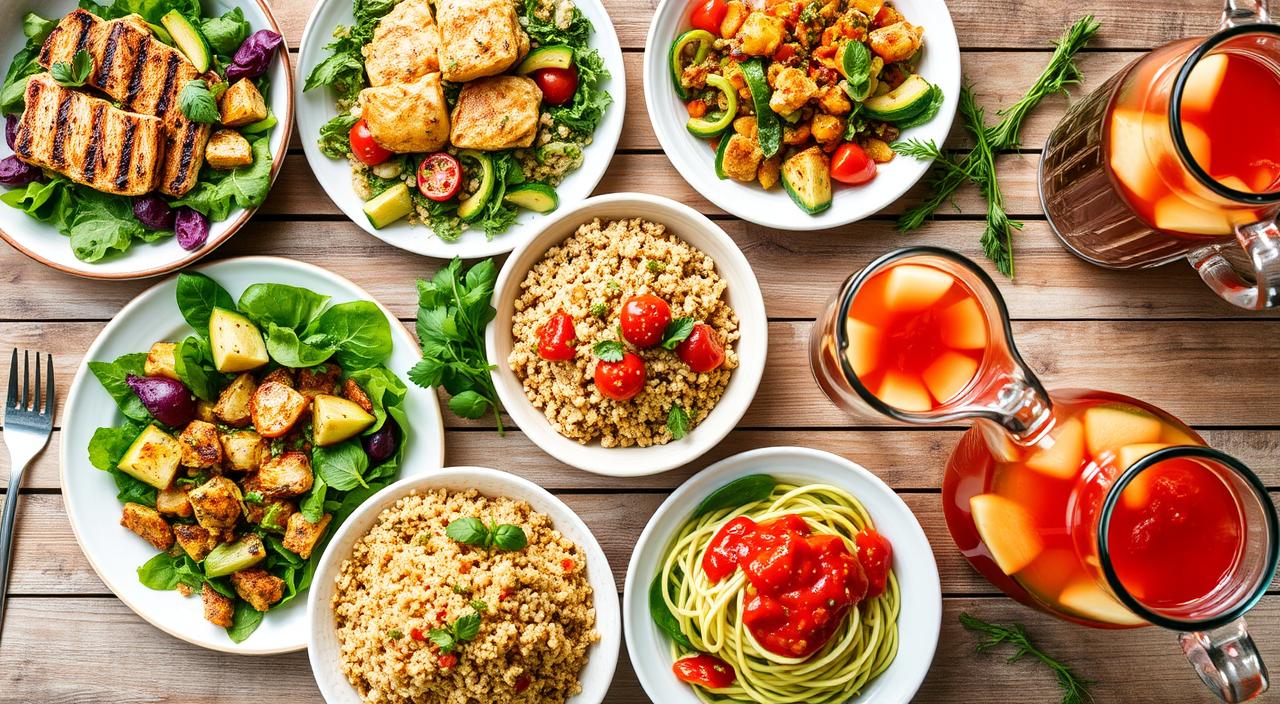Starting a weight loss journey can change your life, especially after bariatric surgery. It’s important to know about healthy bariatric recipes for lasting success. These recipes offer nutritious meals with lean proteins, healthy fats, and lots of veggies.
By choosing well-planned meals, you can control hunger and improve your health. Nutrition is key after surgery. Making smart food choices is vital for losing weight and staying healthy in the long run.
Key Takeaways
- Healthy bariatric recipes are crucial for effective weight loss.
- Nutrition post-surgery significantly impacts overall wellness.
- Incorporating lean proteins and healthy fats is key.
- Well-planned meals help in managing hunger effectively.
- Making informed dietary choices ensures long-term health success.
Understanding Bariatric Cooking
Bariatric cooking is a special way of cooking for people who have had weight-loss surgery. It focuses on making meals that are full of nutrients but have fewer calories. Knowing about these recipes is key for lasting weight loss.
What Makes Bariatric Recipes Unique?
Bariatric recipes are different because they pack a lot of nutrition into small portions. They aim to make meals that are filling but won’t cause you to eat too much. They use lean proteins, fiber, and healthy fats to achieve this balance.
The Role of Portion Control in Bariatric Meals
Controlling how much you eat is very important in bariatric cooking. It helps prevent eating too much and supports planning meals well. Using small plates, measuring food, and eating at set times can help. These habits help you have a healthier relationship with food, which is good for keeping weight off over time.
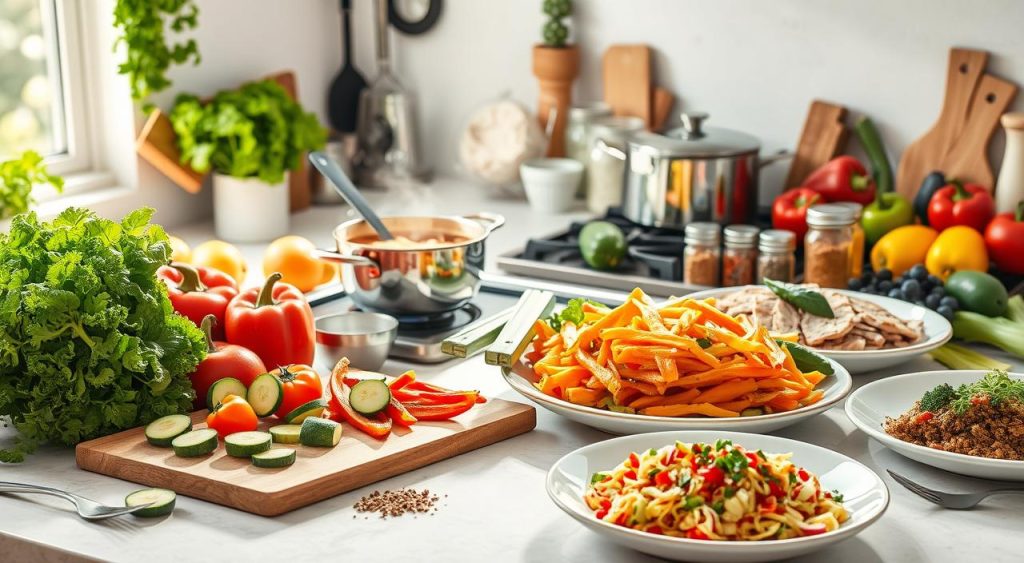
Benefits of Healthy Bariatric Recipes
Healthy bariatric recipes bring many benefits beyond just weight loss. They ensure you get the right nutrients for your body. This helps your body work well and keeps you healthy.
How Nutrition Supports Weight Loss
Healthy bariatric recipes focus on foods that are full of nutrients. They help you feel full without eating too much. Foods high in protein are key to keeping your muscles strong while you lose weight.
Long-term Health Benefits of Bariatric Nutrition
Healthy bariatric recipes lead to lasting health gains. A good diet keeps your metabolism going and lowers disease risks. It’s a step towards a healthier life and better weight management over time.
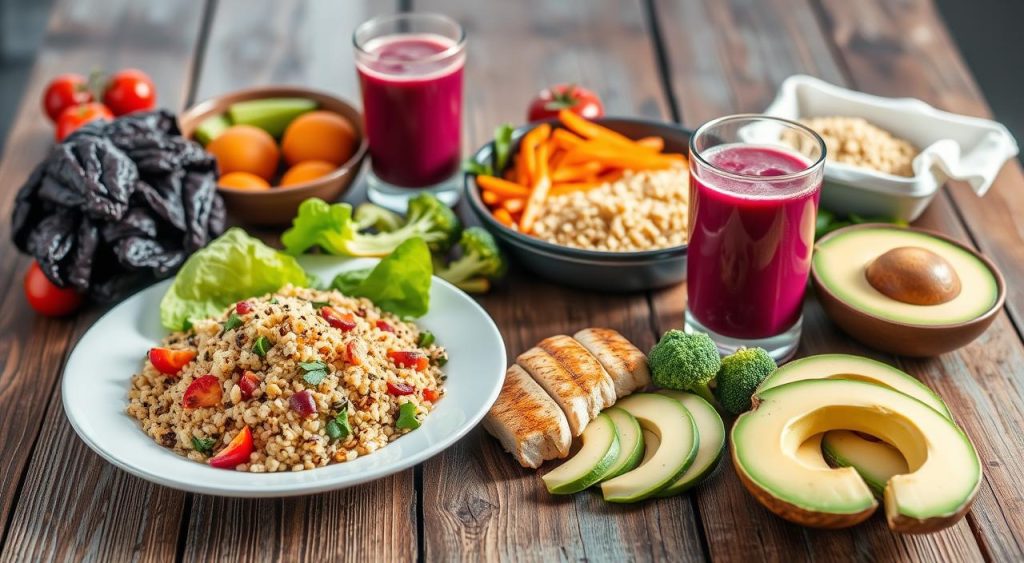
Essential Ingredients in Bariatric Recipes
Creating bariatric recipes means knowing the key ingredients. The right mix boosts flavor and supports weight loss. This part talks about the main parts of a bariatric diet.
Protein-Rich Foods for Muscle Maintenance
Protein is key for keeping muscle while losing weight. Foods like chicken, turkey, fish, and legumes help. They keep you full and boost health and energy.
Incorporating Vegetables for Nutritional Balance
Vegetables are the base of a balanced bariatric diet. They include leafy greens, colorful peppers, and more. They add vitamins, minerals, and fiber, helping digestion and nutrition.
Healthy Fats: Why They Matter
Healthy fats, like those in avocados, nuts, and olive oil, are vital. They make meals more filling. They also help absorb vitamins, supporting nutrition and weight loss.
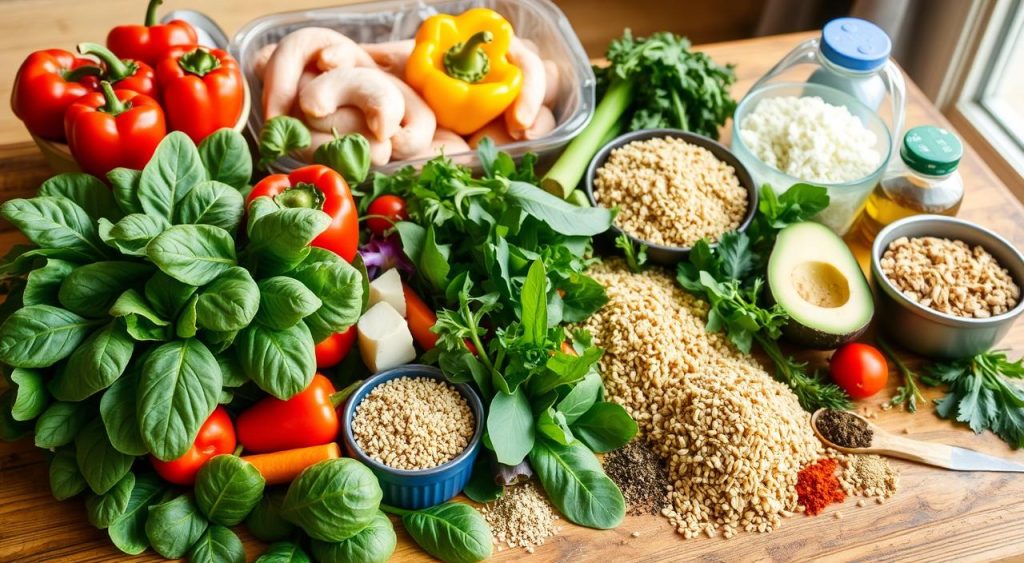
Easy Bariatric Recipes for Beginners
Starting your bariatric cooking journey can seem daunting. But, it doesn’t have to be. Easy bariatric recipes for beginners make quick meals that help with weight loss. Simple, yet nutritious options are key for healthy eating habits.
Quick Breakfast Options
Starting your day with a healthy meal is important. Try protein smoothies or egg muffins for a quick breakfast. A smoothie with spinach, banana, and protein powder gives you vitamins and energy. Egg muffins offer flavor variety and easy portion control.
Simple Lunch Ideas
Lunch should be easy yet fulfilling. Salads with lean proteins like grilled chicken or turkey, and healthy dressings are great. These meals keep your energy up all day. For more simple lunch ideas, check out this resource.
Effortless Dinner Recipes
Dinner can be both simple and healthy. Choose baked fish with roasted vegetables. This recipe is full of flavor and fits well with a bariatric diet. Focus on healthy ingredients and enjoy the cooking process for meals that are satisfying and right for your diet.
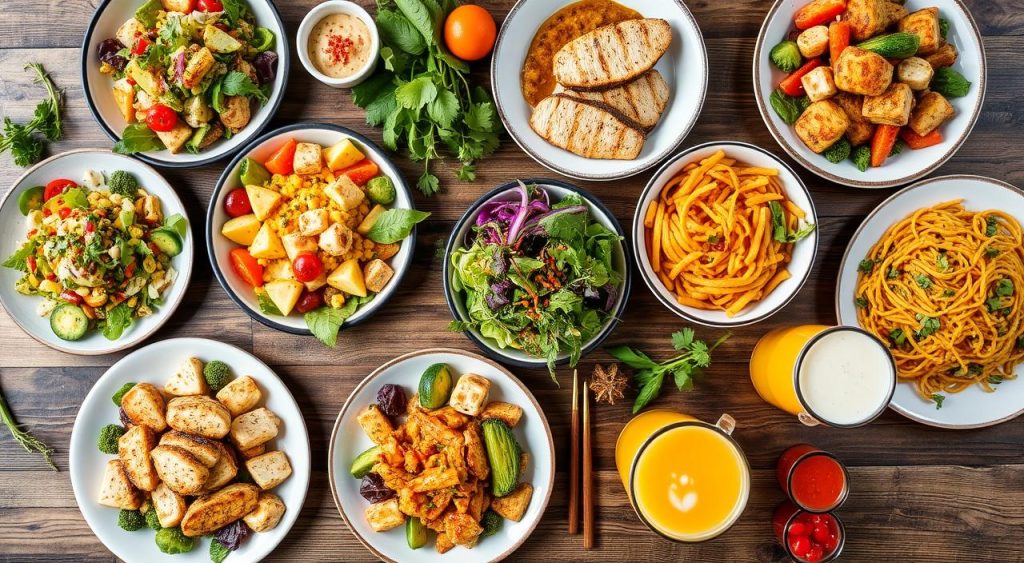
Meal Prep Tips for Bariatric Success
Meal prep is key for those on a bariatric journey. It involves batch cooking and storing food well. This keeps healthy meals ready and easy to enjoy. It saves time and helps you eat better.
Batch Cooking for Convenience
Batch cooking makes meal prep easier by cooking many meals at once. It saves time and makes healthy meals more available. The main benefits are:
- Time savings: Cooking in bulk means you don’t have to cook every day.
- Variety: Cooking different meals at once keeps your diet interesting.
- Portion control: It’s easy to make meals in the right size for your needs.
Storing and Reheating Healthy Meals
Storing food well is crucial to keep meals fresh and tasty. Use airtight containers in the fridge or freezer. Here’s how to reheat meals:
- Microwave: Quick and simple, works for most dishes.
- Oven: Best for casseroles and baked goods, keeps texture good.
- Stovetop: Great for soups and stews, heats evenly.
Delicious Bariatric Recipes to Try
Trying new bariatric recipes can make eating healthy fun and fulfilling. Adding different flavors and textures to meals makes them more enjoyable. It also helps meet nutritional needs. Here are some tasty options, like savory soups, healthy salads, and low-carb snacks and sweets.
Savory Soups and Stews
Soups and stews offer comfort and nutrition. Choose recipes with lean proteins and lots of veggies for health benefits. A warm lentil soup or chicken and veggie stew is comforting and low-calorie.
These dishes are not just filling. They also provide important nutrients.
Wholesome Salads
Salads can be more than just greens. Mixing colorful veggies, lean proteins, and healthy fats makes a balanced meal. Add grilled chicken, chickpeas, and raw veggies with a light vinaigrette for flavor.
These salads are satisfying and low in carbs. They support your bariatric journey.
Low-Carb Snacks and Sweets
Craving something sweet or a quick snack doesn’t mean giving up on health. Try low-carb snacks like veggie sticks with hummus or cheese crisps. They offer satisfaction and nutrition.
For dessert, make healthy sweets like sugar-free chocolate bites or a berry parfait with Greek yogurt. These options satisfy cravings while staying on track with your diet.
Adapting Family Recipes for Bariatric Diets
Changing family recipes for bariatric diets is a rewarding journey. It makes meals healthier while keeping the flavors loved for years. By making simple ingredient swaps, you can cut calories and boost nutrition. This way, family meals become both tasty and good for everyone’s health.
Making Traditional Meals Healthier
One smart way to update recipes is to swap out high-calorie items for better choices. Here are some tips:
- Use lean meats like chicken or turkey instead of fatty cuts of beef or pork.
- Incorporate whole grains like quinoa or brown rice instead of white rice or pasta.
- Sneak in vegetables to add nutrients and fiber, enhancing both taste and health benefits.
- Experiment with herbs and spices to deepen flavor without adding extra calories.
Involving Family in Healthy Cooking
Getting family involved in cooking creates a supportive space for healthy meals. By working together, everyone can help make recipes fit bariatric diets. This teamwork not only strengthens family ties but also encourages healthier eating for all. Here are ways to get family involved:
- Assigning tasks based on age and ability during meal prep.
- Setting aside time each week to try new healthy recipes together.
- Discussing the benefits of eating healthier to motivate everyone.
Challenges in Bariatric Cooking and How to Overcome Them
Bariatric cooking comes with its own set of challenges. It’s all about keeping meals tasty without too many calories. With some creativity, you can make dishes that taste great and fit your diet.
Maintaining Flavor without Excess Calories
Getting flavor without calories is a big challenge. Traditional sauces and seasonings often add too many calories. Here’s how to beat this:
- Use fresh herbs like basil, cilantro, or thyme to add flavor.
- Try spices like cumin, paprika, or garlic powder for extra taste without calories.
- Use citrus juices and vinegars to make dishes light and zesty.
These tips help you make tasty meals that are also healthy. It shows that you can have great flavor and stay on track with your diet.
Coping with Dietary Restrictions
Dietary restrictions can also be a big challenge. Some people must avoid certain foods due to allergies or intolerances. But, with a little creativity, you can adapt recipes easily. Here’s how:
- Swap out ingredients with alternatives, like almond flour for gluten-free options.
- Make your own seasoning blends to match your taste preferences.
- Use appliances like steamers or air fryers for healthier cooking methods.
By tackling these challenges, you can enjoy every meal while sticking to your dietary needs. This leads to a healthier lifestyle.
Finding Inspiration for Bariatric Recipes
Looking at different sources can really change how you see bariatric food. Cookbooks, online sites, and bariatric groups offer many ideas. These are all made for people with specific dietary needs.
Using Cookbooks and Online Resources
Special cookbooks for bariatric diets have recipes that are just right. They focus on the right amount of food, nutrients, and taste. You’ll find easy-to-follow recipes and meal plans in these books.
Online, blogs and recipe sites are full of meal ideas. Sites like cooking blogs have recipes that fit bariatric diets. They let you try new things with food.
Engaging with Bariatric Communities
Joining bariatric groups on social media can also help. These groups are places where people share their bariatric diet experiences. They talk about successes and challenges, and share tips and recipes.
Talking with others who get it can really motivate you. It makes planning meals feel less scary.
Conclusion
Adding healthy bariatric recipes to your daily life is more than starting a diet. It’s a choice for a lasting lifestyle that helps with weight loss and health. Choosing nutritious foods brings many benefits, not just for losing weight but for feeling better overall.
These recipes show how important it is to eat balanced meals. They should have lots of protein, veggies, and good fats. Making meals this way can be fun, not a hassle. With smart planning and getting your family involved, you can make tasty, healthy food that’s right for you.
The path to losing weight and getting healthier is all about being creative and flexible. Trying different cooking styles and flavors makes healthy bariatric recipes not only good for you but also enjoyable. This is a big step towards a healthier life.
FAQ
What are healthy bariatric recipes?
Healthy bariatric recipes are meals made for people who have had bariatric surgery. They focus on foods that help with weight loss and health. These include lean proteins, healthy fats, and veggies.
How do I start meal planning for bariatric cooking?
Start by planning meals that are small and full of nutrients. Make a weekly menu with quick and easy meals. Include protein, veggies, and healthy fats. Use cookbooks and online sites for bariatric recipes.
Why is portion control important in bariatric recipes?
Portion control is key to avoid eating too much. It helps keep your calorie intake low. This way, you get the nutrients you need without gaining weight.
What are some easy bariatric recipes for beginners?
Beginners can try protein smoothies for breakfast, salads with lean proteins for lunch, and baked fish with veggies for dinner. These recipes are easy to make and packed with nutrients.
How can I prepare meals in advance for bariatric success?
Prepare meals in advance by batch cooking. Cook a lot of healthy meals at once and store them. Use the fridge or freezer to keep meals fresh. Reheat safely to keep meals tasty and nutritious.
What are some benefits of incorporating vegetables into bariatric recipes?
Adding veggies to recipes boosts fiber, vitamins, and minerals. They help with digestion and make meals more nutritious. Plus, they’re low in calories.
How can I adapt family recipes to fit a bariatric diet?
Adapt family recipes by swapping ingredients. Use whole grains instead of refined ones and choose healthier fats. Cooking together can make healthy eating a family affair.
What challenges might I face in bariatric cooking, and how can I overcome them?
Challenges include keeping meals tasty without too many calories and following dietary rules. Use herbs and spices for flavor and get creative with ingredients. This way, meals stay enjoyable and healthy.
Where can I find inspiration for bariatric recipes?
Find inspiration in cookbooks, online blogs, and social media groups. These places offer support, ideas, and a chance to share recipes and experiences.

